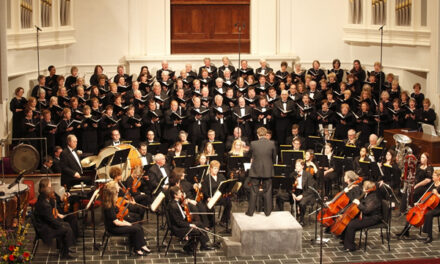Since taking up the pen here in 1977, I’ve followed with interest the work of Paul Conway and the substantial vocal ensemble now known as the Hillyer Community Chorus. According to a note in the program for its recent concert, it was a relatively mature group even then, having been established in 1970 for the purpose of presenting major choral works. In 1970, there were only two choirs of note in the region, aside from college- and university-based groups – the Raleigh Oratorio Society and the Durham Civic Choral Society, formed by Bull City singers who tired of the commute to the capital…. As the NC Master Chorale and Choral Society of Durham, both remain strong forces in our region. So, too, do the Hillyer group and its founding conductor. From the outset, Hillyer did things differently from the others – and differently, too, from the many other groups that have popped up since the ’70s. The Hillyer concerts are free. They almost always involve orchestral accompaniment. And nine times out of ten – or maybe even 64 times out of 66 or so – they involve works rarely if ever heard hereabouts previously, and as often as not, US premieres.
This was the case once more on the afternoon of December 7 as six vocal soloists, the choir’s 80 singers, and a 26-piece orchestra filled the front of the filled-to-capacity church for the US premiere of Anton Reicha’s Te Deum (1825). This concert got swept up with “holiday” listings in some places, but there was nothing particularly seasonal about it, aside from decorations in the sanctuary. The Te Deum is one of the great woodwind master’s few sacred works, and the uncredited program notes (we’re guessing they were by Johnnie Conway) reveal that “the occasion for which it was composed” is not known, but that it’s possible its intended “use was not strictly religious.” It is certainly a grand and sometimes grandiose thing, so this conclusion makes sense. It’s also hard to imagine a typical church of the period being able to engage (much less have on hand) six soloists, four of which are called upon to make quasi-operatic contributions. For this superb reading, the soloists were sopranos Mary Kathryn Walston and Mary Schoneman, alto Nancy Brenner, tenors David T. Manning and Greg Clagett, and bass Lewis Moore, and they did generally handsome work. The orchestra was headed by Toby Weinstein, and it was among the best yet engaged for these concerts. The choir has nearly twice as many women as men, but balances were rock-solid. The playing and singing seemed secure and precise – it’s always a challenge to judge this, in the case of “new” works, but the results were consistently satisfying.
The work itself is divided into eleven sections, not all of which appear in everyday settings of hymns of praise – among the relatively atypical parts are “Te gloriosus Apostolorum chorus,” for all six soloists; “Te per orbem terrarum,” for bass; “Tu ad liberandum,” for soprano and tenor; and a magnificent “Dignare dominie,” for tenor solo and chorus. The principal soloists were nicely matched, singing well in solo bits and together. Only the lead tenor seemed to have difficulty, and only rarely, with the tessitura – as noted, this piece often borders on the operatic. The lead soprano and Moore were particularly impressive. And the chorus impressed, too. There have been times during the long Hillyer run when things were a bit rough and not always ready, but there was little evidence of such on this occasion; instead, the sections were strong and unified, the attacks and releases were spot on, and the diction and projection were good. Conway led with his customary spirit and enthusiasm, and the performance was warmly applauded by the crowd.
Since Reich’s Te Deum lasts only about 45 minutes, the program began with a curtain-raiser of sorts, David Popper’s brief Hungarian Rhapsody, listed in the program as “No. 4” but most likely the same work recorded by Feuermann, Starker, and others. The cello soloist was Joel Wenger, and he enjoyed excellent orchestral support, after a somewhat tentative introduction. His playing took on certain aspects of gypsy fiddling from time to time, and it’s unclear whether the portamenti and slides were all intentional, but he was effective enough in the familiar Magyar tunes that give the work so much color. The young soloist was rewarded with extended applause.
The program’s only serious shortcoming was the absence of biographical information about the solo artists.
The next concert by the Hillyer Community Chorus is scheduled for May 16, at 7:00 p.m., in the Hillsborough Street sanctuary. It’s a safe bet that the program will involve yet another rarity, tracked down by our leading purveyor of unknown choral music. Be there!











